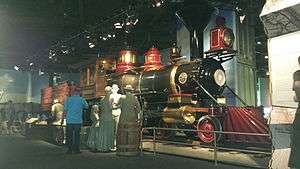Santa Cruz Railroad no. 3
|
The Jupiter on display in the National Museum of American History. | |||||||||||||||||||||
| |||||||||||||||||||||
| |||||||||||||||||||||
| |||||||||||||||||||||
| |||||||||||||||||||||
The Santa Cruz Railroad no. 3 is a narrow gauge steam locomotive in Washington D.C.. It is one of three preserved Baldwin Class 8/18 C 4-4-0 locomotives in the United States, the other two being the North Pacific Coast Railroad no. 12, the "Sonoma" displayed at the California State Railroad Museum, and the Eureka and Palisade Railroad no. 4, the "Eureka" which is privately owned, the latter of which it is the only operable example.[2] It was common practice for American railroads of the 19th century to name their engines after Jupiter, "King of Gods", and other mythological figures to attract attention, thus the engine should not be confused with the engine of Golden Spike fame.
History
The locomotive was built in 1876 for the Santa Cruz Railroad, which was built to transport passengers and goods from the town of Santa Cruz, California to connect with the Southern Pacific Railroad in Watsonville. The engine served on this railroad until 1883, when the railroad was bought by the Southern Pacific and converted to Standard gauge. As converting the engines to the wider gauge would be costly and uneconomical, the railroad elected to sell off the inherited engines and use its own Standard gauge engines instead. As such, the Jupiter was sold to the United Fruit Company, which sent the engine to Guatemala to operate on its subsidiary, the International Railways of Central America. The engine's name was dropped and the IRCA had renumbered the engine as no. 84. As such the engine transported fruit and a small number of passengers along one of the railroad's branchlines in the northwestern part of the country until 1960.
In the 1960s, United Fruit was purchased by New York entrepreneur and DC Transit operator O. Roy Chalk. For reasons unknown, Chalk selected the former Jupiter locomotive for display as part of a children's park he was developing in Washington D.C., and the engine was shipped to that city to be displayed. In D.C., the engine drew the attention of Smithsonian Institution curator John H. White, Jr., who had taken particular notice of the engine's year built. White convinced Chalk to donate the engine to the Smithsonian as part of their upcoming Bicentennial Exhibition of 1976. The engine was cosmetically restored to its as-delivered appearance, and placed on display in the Smithsonian's Arts and Industries Building in 1976 for the exhibit, which was a recreation of the displays of the Centennial Exposition of 1876.[3] The engine was displayed in this building until 1999, when it was relocated to the Smithsonian's National Museum of American History on the opposite side of the National Mall, initially placed beside Southern Railway engine 1401. The engine was relocated again in 2004 (though it remained within the museum building) when the exhibits were reconfigured into the America on the Move exhibition, which features the engine displayed as part of a diorama recreating its arrival in Santa Cruz in 1876.
References
- ↑ "Santa Cruz Railroad No. 3". Steamlocomotive.info.
- ↑ "Las Vegas, Nevada". Official City of Las Vegas. Archived from the original on September 27, 2007. Retrieved March 20, 2007.
- ↑ "Steam locomotive Jupiter". America on the Move. National Museum of American History.
